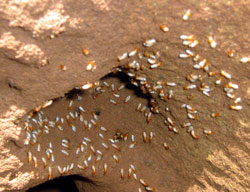Termites are successful because of their ability to utilize cellulose as food. As a result some species may incidentally damage wood in structures, stored books or other materials.
What species of termites are local to Colorado?
At least three species of subterranean termites (Reticulitermes spp.) are native to Colorado and they can be locally common. Most widespread is the aridland subterranean termite, R. tibialis, which may be found throughout most of the state below about 7500 ft. It is very common in the eastern plains where it often is easily found when turning over fallen logs or dried cattle manure.
What are the main characteristics of termites?
Termites are classified by the type of nest they build. In Colorado, the eastern subterranean termite is usually responsible for damage to structures. This is the same  species that is a pest in the Northeast. These termites usually maintain contact with the soil in which the main nest is found. They search outside their nest for wood to feed on and construct earthen tubes from the nest to the food source. There is also a small area in Grand Junction affected by drywood termites, which require different management tactics.
species that is a pest in the Northeast. These termites usually maintain contact with the soil in which the main nest is found. They search outside their nest for wood to feed on and construct earthen tubes from the nest to the food source. There is also a small area in Grand Junction affected by drywood termites, which require different management tactics.
Is termite damage common in Colorado?
Damage by termites to structures in Colorado has not been very common – at least in comparison to areas of the US that are wetter and/or warmer. Historically, injury has been most common in locations where local water tables are high, supplying subsurface moisture critical to their survival.Termite damage has long been reported from Del Norte in the San Luis Valley and Burlington on the eastern plains where this condition occurs.
Do humans change the nature of termites?
Human activities, particularly landscaping practices, have greatly changed the termite picture within Colorado. Infestations of buildings and presence in yards are now more common in many residential areas of the state. Much of this is due to increased moisture around buildings from poorly directed landscape irrigation and poor management of downspout drainage close to foundation walls. The presence of abundant amounts of buried wood in the form of fence posts, tree stumps, firewood piles and similar items provide many food sources for termites.
Contributing to increased problems with termite damage is the widespread misperception that “there are no termites in Colorado”. As a result housing construction often has given little attention to the basics of termite-proofing that are standard practice in areas where termites are better recognized and respected. Many buildings provide sites of direct wood-soil contact or access openings to termites that practically invite problems.
More information on termites is available in Extension Fact Sheet 5.532 Termites.



